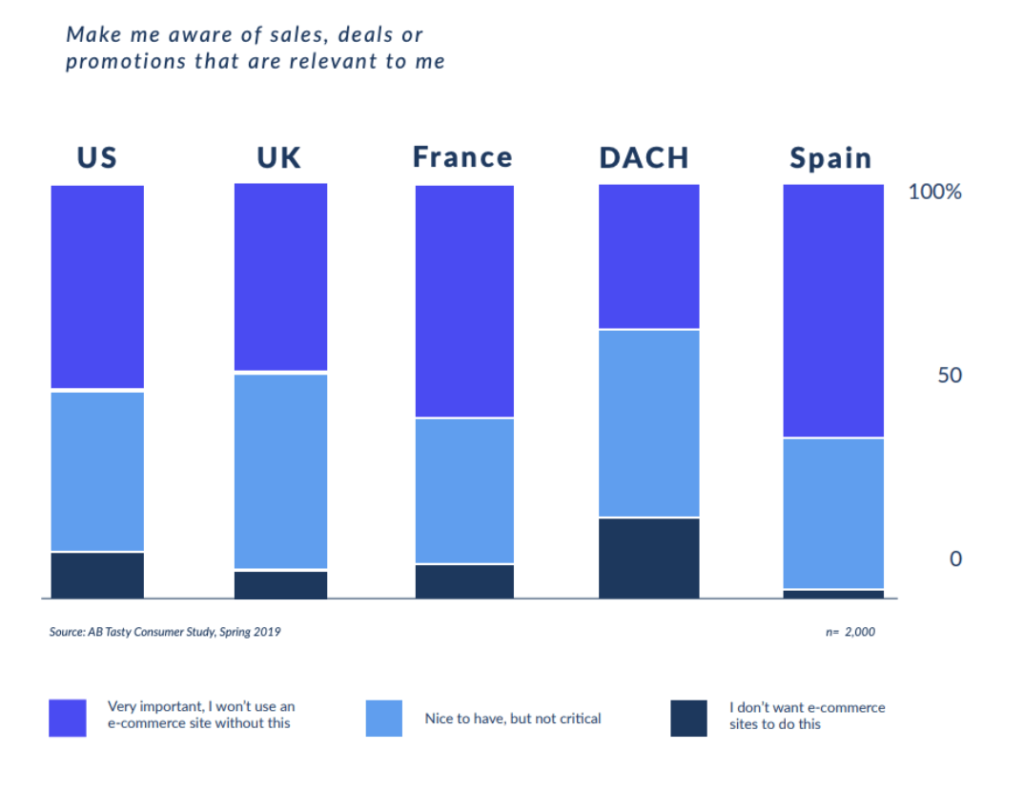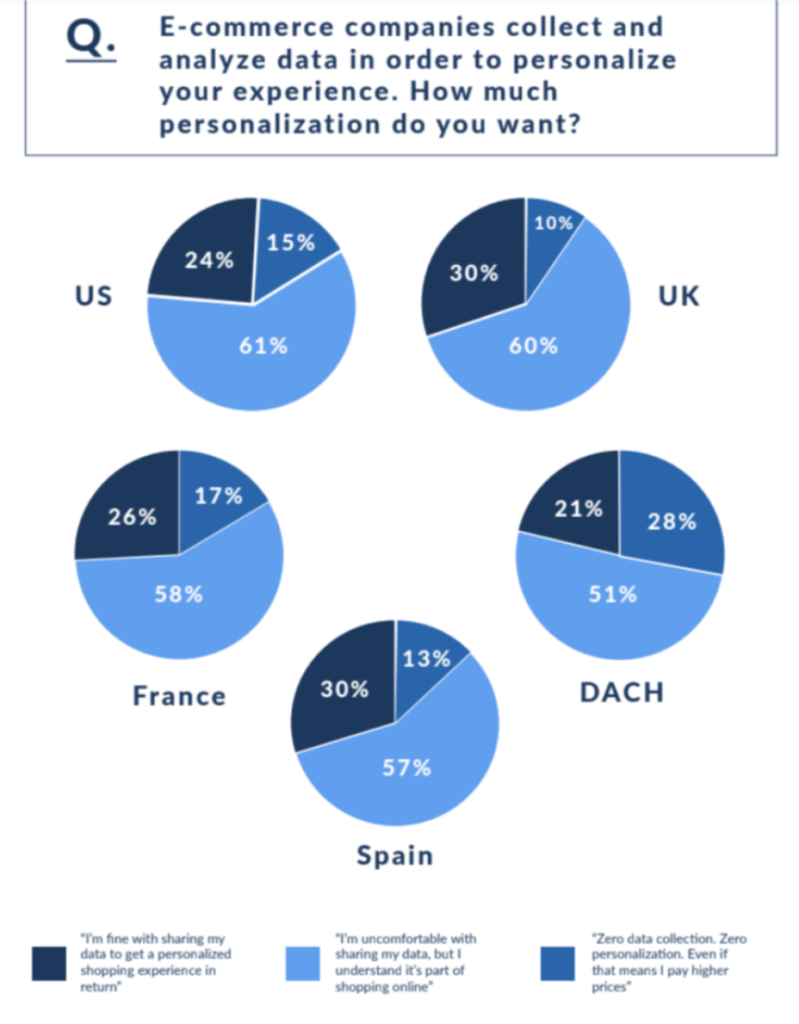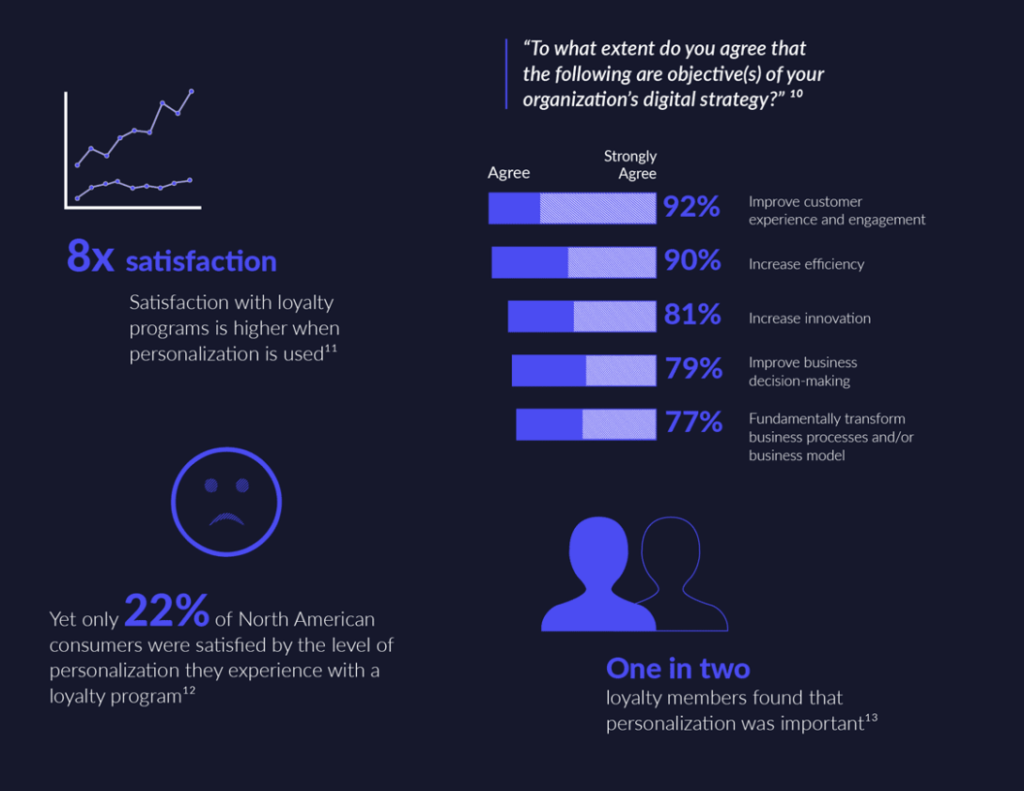Every ecommerce sale can be tied to a decision made by the consumer. There’s a moment in the customer journey process that sways people to buy or pass on a product.
What defines this moment?
I often get asked what makes or breaks an online purchase. If you don’t know the answer to this, then you can’t run a successful ecommerce operation.
Lots of experts out there will tell you to “do this” or “do that” to increase ecommerce sales. But I always let the data do the talking for me.
Sure—in theory, nearly every strategy sounds good. However, if you can’t tie those strategies to concrete evidence, then it’s just guesswork. I don’t know about you, but I wouldn’t let my business rest in the hands of someone’s best guess.
That’s why I’m always on the hunt for the newest research and studies related to ecommerce and consumer behavior.
I recently stumbled upon an ebook called Understanding the Future of Ecommerce Personalization, published by AB Tasty.
The ebook reports the findings of a study where 2,000 people were surveyed throughout the globe. The survey questions were used to discover the advantages, concerns, and frustrations of consumers shopping online.
Based on these findings, I was able to draw conclusions on the factors that make or break an ecommerce sale.
When in doubt, turn to the data. All of the data below came from the AB Tasty report. I’ve thrown in my own two cents as well to provide actionable steps for ecommerce websites.
Improve Your Product Pages
Any visitor that lands on your product pages didn’t do so by mistake. By this point in the buying process, the consumer has already identified their need or want for a specific product.
From your product page, people are just a click or two away from finalizing a purchase. That’s why these pages need to be perfect.
It’s no secret that the ecommerce industry is booming. People are buying online more than ever before. But with that said, the process of buying something online has its flaws.
According to the research by AB Tasty, being unable to touch, feel, and examine a product is the most frustrating part about shopping online.
As you can see from the graph, this response dominated the other pain points.
Touching or feeling a product through the Internet is obviously not realistic, at least not in this lifetime. So your product pages must emulate that in-store experience as much as possible.
One or two images just won’t get the job done. You need to use lots of high-quality images of whatever you’re selling and show the product from every angle. The idea here is that you don’t want your customers to be surprised when the product arrives at their doorstep. It should be clear based on the product page. If there is any doubt, the consumer won’t buy.
Subtle changes on your product page can make a huge difference.
For example, Seafolly, an Australian swimwear brand, increased transactions by 7% after simply enlarging photos in their shopping carts.
A highly optimized product page goes beyond photos. It encompasses your branding, pricing, product descriptions, and more.
Analyze your existing product pages and ask yourself if you’re telling the full story. Can a customer look at this page and get all of the information that they would get if they could touch or feel it in a store?
I could argue that selling online gives you an advantage to brick and mortar shopping. In a store, customers can’t read a product description or watch a video demonstration of how to use the item. Use these tools to your advantage.
Offer Free and Fast Shipping
Price will always have an impact on the consumer’s decision to buy. People will look at the cost of your products and immediately decide if they are still interested.
There is nothing wrong with this. Your pricing strategy shouldn’t appeal to everyone and anyone with Internet access.
But when you add on extra fees, like shipping costs, it can turn people away who were previously interesting in buying.
If you refer back to the graph about the biggest pain points of buying online, you’ll see that “surprise fees” is tied for second in terms of the highest response rate at 17%. Furthermore, 10% of people surveyed said that “shipping times” were the most frustrating part about shopping online.
That means more than one-fourth of consumers worldwide have frustrations and pain points related to shipping when they shop online.
This is something that you can’t afford to ignore. Your shipping practices could be turning away one in four shoppers that land on your website.
Whether you’d like to admit it or not, you’re competing with Amazon. Your customers are used to getting two-day or even next-day free shipping. That’s become the new standard in online shopping.
So it’s hard for people to justify paying $7.99 in shipping costs to get their package delivered in a week. You need to offer fast and free shipping. There’s no way around it.
If necessary, adjust the prices of the products to make up for the difference. Even if it means a 10% or 20% raise in your pricing across the board. As long as your customers aren’t seeing prices that they perceive as “extra” it will increase their chances of buying.
Run Sales and Promotions
Personalization was a major theme in the study published by AB Tasty. After all, the word “personalization” is in the title of their ebook.
The reason why personalization is such a key factor in making or breaking an ecommerce sale is because it starts early on in the buying process. You can’t wait until the checkout page to try and implement a personalization strategy. But personalized sales and offers will guide your customers to make a decision.
Take a look at this graph, which gives a global perspective on how consumers feel about personalized sales, deals, and promotions.

While the results vary slightly by region, you can see that the majority (nearly 50% or more) in four of the five regions say they wouldn’t even shop at an ecommerce site that didn’t give them personalized offers.
At a minimum, the overwhelming amount of consumers surveyed agreed that personalized options were nice to have.
Just a fraction of respondents in every region said that they don’t want personalized offers. But you need to stick with the majority here.
Personalized offers can come in all different shapes and sizes. For your existing customers, it could mean sending them an email with a new product or discount related to their purchase history.
For example, let’s say you own an online sports equipment store. A customer buys a snowboard and snowboarding boots. After they make that purchase, you can send them an email for discounts on things like snowboarding goggles, a snowboarding jacket, a ski mask, and gloves.
Sometimes personalization can be based on something simple, like the physical location of your website visitor.
If someone is shopping from Hawaii, you probably shouldn’t be promoting snowboards and skiing equipment on the homepage. A surfboard, kayak, or paddleboard would be a better option.
Be Transparent About Data Security
To truly personalize the customer experience, ecommerce brands are collecting data related to the browsing behavior of website visitors.
While consumers want personalized offers, they still have concerns about privacy. Based on the graph we saw earlier about the frustrations of online shopping, 17% of consumers say they are worried about the privacy of their personal data. That was the second highest response on the list.
AB Tasty took that one step further, by asking consumers how they felt specifically about this topic. These are the results:

The results are pretty similar in every region. The majority of people admit that they are uncomfortable sharing their personal data, but they understand that it’s part of shopping online.
Roughly 25% of consumers are fine with data collection and don’t have any concerns about it.
A small, but still significant, percentage of respondents say they don’t want any data collection. They would even be willing to pay higher prices to avoid it.
I found these results interesting, especially when you compare them to the graph that we saw earlier related to consumers wanting personalized sales and promotions.
There is no doubt that people want personalized offers. But they are still uneasy about where those offers come from. The idea of being tracked online makes people uncomfortable.
It’s all about context. As an ecommerce store, you need to understand this.
Be transparent and tell your website visitors how and why you’re using data collection practices. Emphasize the benefits, instead of just stating that you collect data. Explain that the value of personalization outweighs any perceived disadvantages of data collection.
Entice Customer Loyalty
One of the biggest benefits of ecommerce personalization is customer loyalty.
It benefits you as the store owner because your customers will keep coming back and buying more products. But it also benefits the customer because it improves their online shopping experience.
Check out the statistics on this infographic related to personalization and customer loyalty.
The results show that simply offering a customer loyalty program isn’t enough. The most successful loyalty programs are paired with personalization.
In fact, customer satisfaction with loyalty programs is eight times higher when personalization is used. So how can you accomplish this?
The best customer loyalty programs are based on rewards. So you need to find a way to reward your customers for shopping. But if you treat all customers and purchases the same, it won’t add any personalized value to each person.
Think of a punch card at a local coffee shop. Every time you buy a coffee, the cashier punches a hole in the card. After you buy nine coffees, the tenth one is free. That’s a basic loyalty program.
The problem with this system is that it treats all purchases the same. Customers buying a $1 espresso are getting the same rewards as someone buying a large $7 specialty drink.
So when you create an ecommerce loyalty program, you could reward customers based on the amount they spend, rather than just the frequency of their purchases.
This adds a higher level of personalization to the program since no two people will have the exact same total spending. When a customer tracks their status in the loyalty program, they can clearly see that the offers are geared specifically toward them.
AB Testing
Your ecommerce store will never be perfect.
Yes—you can use the tips I’ve used in this guide to make changes to your product pages, homepage, and checkout process. But there will always be room for improvement.
The best way to fully optimize your website for conversions is by running A/B tests. Again, this takes the guesswork out of your decisions.
Rather than just assuming that your CTA button phrasing, color, and placement is correct, test out different variations to see which one converts at the highest rate. This is a constant process. You should always be testing different elements of your site to optimize it for conversions.
Conclusion
So what makes or breaks an ecommerce purchase? It’s not just one thing.
As a whole, there are several elements and factors that influence a consumer’s decision to buy or look elsewhere for their needs.
Refer to the data. Overall, personalization converts.
Brands that use digital tools and data to create a personalized shopping experience increase revenues two to three times faster than brands that don’t.
98% of marketers say that website personalization is a valuable method for improving conversion rates. 59% of businesses say that sales revenue is a direct benefit of digital personalization.
If you want more information and data about ecommerce personalization from a global perspective, you can read the full report published by AB Tasty.

